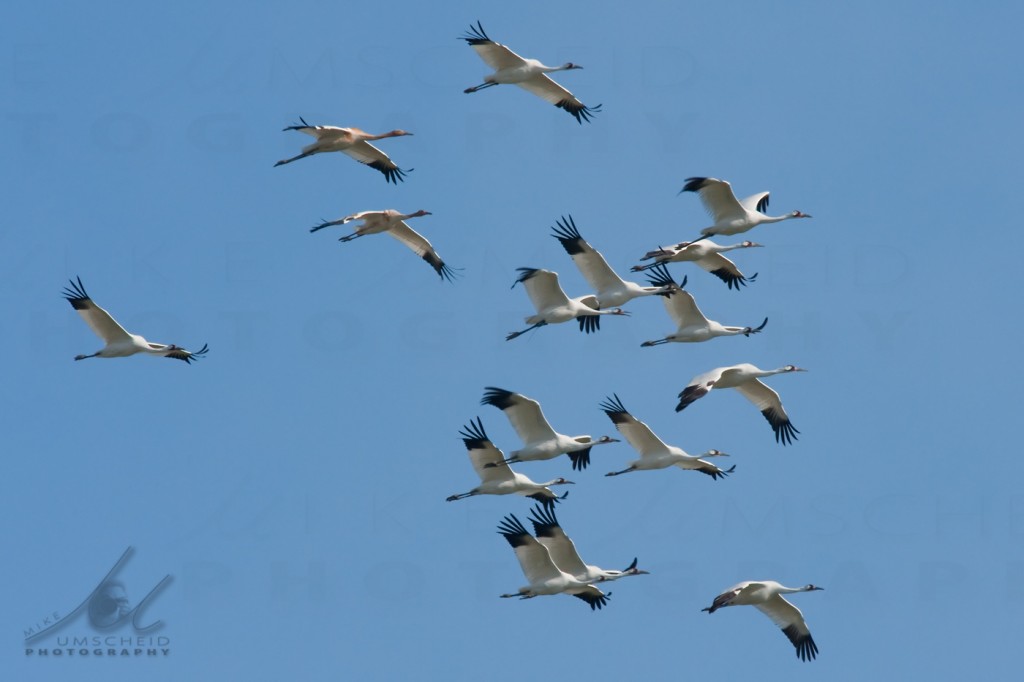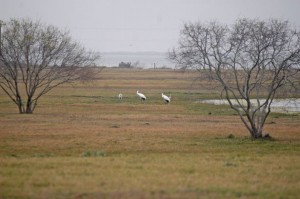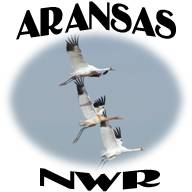Archive for November 29, 2012
Citizens Help Monitor Whooping Cranes
November 29, 2012By Chester McConnell, Whooping Crane Conservation Association
Whooping cranes, being our national symbol of conservation, create tremendous interest. All birders would love to have whoopers on their “life list”. Indeed, the average nature buff gets all excited when they are lucky enough to see a whooping crane. And you have got to be lucky or, for many, be willing to travel long distance to observe these magnificent, endangered birds.
They are the tallest bird in North America, standing nearly 5 feet tall, with a 7 foot wing span, so why are they so hard to find. Well, first there are only 405 known to be in the wild. And most spend several months nesting in the vast wetlands of northern Canada at Wood Buffalo National Park, a place very difficult to get to. Then when these approximate 266 Wood Buffalo birds migrate south in winter, the total Western flock will be scattered along a 200 mile wide by 2,400 mile long migration corridor. And about 139 birds in the Eastern flock will be stretched from Wisconsin to Florida and Louisiana. So this equates to a few whoopers in a vast area. Now you know why you have got to be lucky to spot some of these cranes.
But a lucky few do get to see the whoopers. We know because they report to the Whooping Crane Conservation Association on our web page by clicking on the link: https://whoopingcrane.com/report-a-sighting/ . Normally we receive about 130 reports annually. Our citizen observers report on whoopers located along the migration route from Saskatchewan, Canada to Aransas, Texas and from Wisconsin to Florida. We keep a map showing locations of the reports. Likewise some federal and state agencies also keep their records. Collectively, we attempt to gather as much information as possible to help protect and learn more about whooping cranes.
A number those reporting to the Whooping Crane Conservation Association sent us photos of their observations. One of the photos is shown below. To view more photos, click on the following link: Whooper photos 8 for web article 11-29-12
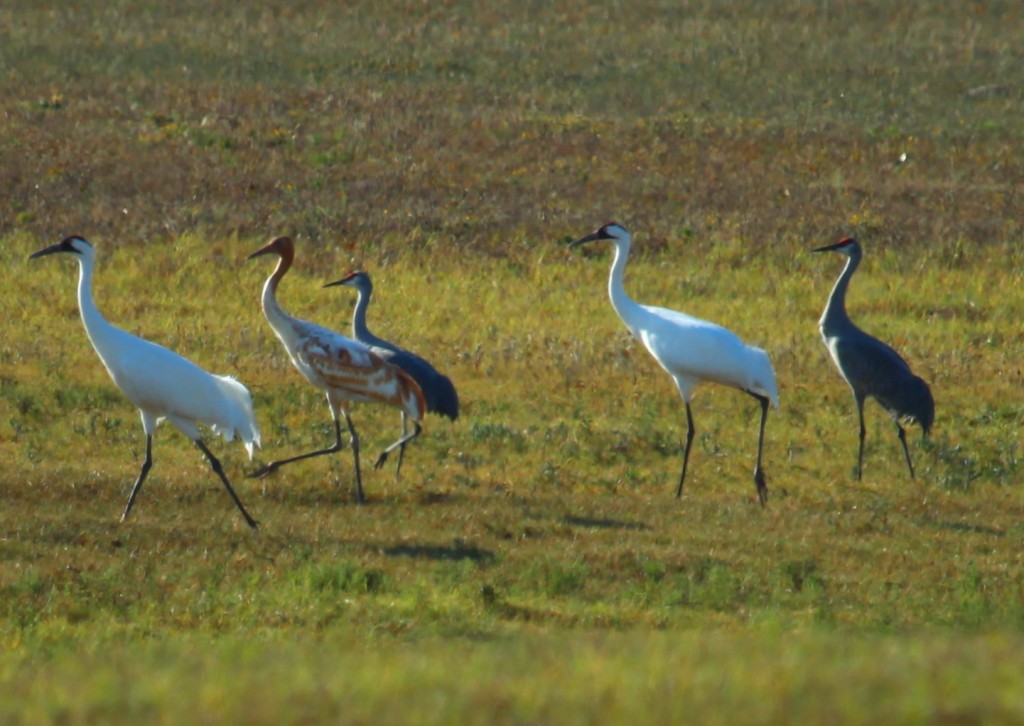
Two adults and one juvenile whooping crane with two sandhill cranes, Rock Port, Texas.
Photo by: Peggy Diaz
The best place to see whoopers is when they reach their winter habitat at Aransas National Wildlife Refuge along the Texas coast. You can ride along refuge roads and see some in fields and marsh land. Or you can climb the new tower on the Refuge and observe whoopers over a vast marsh area. But possibly the best way to observe them is to get on one of the commercial boats at Rockport, TX and ride out to make your observations.
Send Season’s Greetings by Whooper
November 18, 2012This Holiday Season, or for any other special occasion, why not send a Whooper eGreeting?
Select from one of 9 designs in our Greeting Card Gallery.
If your friends, family and loved ones don’t have email, don’t worry – simply print out this DIY Whooper Christmas Card, pop it in an old-fashioned envelope and mail them a reminder that you are thinking about them and that they should be thinking about Whoopers!
Folding Instructions
Print the Whooper Christmas card and place it face down with the Whooper Picture facing away from you.
Fold in half by taking the bottom edge of the paper to the top making a nice even crease. If you are using think paper you may need to score the crease with a knife (careful not to cut all the way through).

Turn the card around so that the Whooper Picture is nearer to you, but still facing down.
Again, bring the bottom edge up to the top making a strong fold. Use the back of a spoon or a ruler to press along the crease if required.
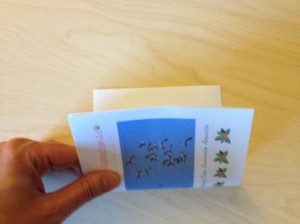
Your card should now be ready for you to fill in your greeting. If the paper is thin you may need a little paper glue or double sided tape to make it look better.
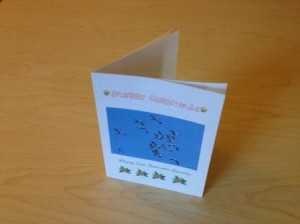
Happy Holidays, and don’t forget – a WCCA Membership Subscription makes a great gift.
Newsletter – Fall 2012
November 18, 2012Rare Whooping Crane Photo
November 13, 2012by Chester McConnell
Whooping Crane Conservation Association
Getting good photographs of members of the Aransas-Wood Buffalo flock of whooping cranes is not easy. First they are wild and cautious. And then there are so few of them (about 300). Generally they are in locations not easy to get to. During this time of year the whoopers are migrating from their nesting habitat in Wood Buffalo National Park, Canada to Aransas National Wildlife Refuge along the Texas coast. They may be observed anywhere along the 2,400 mile migratory route if you are lucky.
Photographer Mike Umscheid is one of those lucky people but I believe that his luck improves the harder he works. Mike recently made some excellent photos of whooping cranes and agreed to share them with the Whooping Crane Conservation Association (WCCA).
Mike’s photo shown below is very unusual because there are 16 whoopers flying together. Two more were with the group. Normally whooping cranes fly in groups of 2 to 8, so a photograph of 16 together is very unlikely.
WCCA communicated with Mike and we share with you his excitement about his recent encounter with the cranes. Mike advised: “I’ve visited the WCCA website before, even before I photographed those cranes, in gathering information on movement of the whoopers, the latest flock numbers, etc. I’ve fallen in love with the whooping crane and it is a bird that I have always wanted to photograph. Needless to say, it was an absolute treasure being around them and having them fly above me (let alone photographing them).”
Mike continues: “I was out at Quivira (National Wildlife Refuge, Kansas) photographing cranes for a couple of days recently. The surge of cranes began to arrive there earlier last week. The whooper numbers peaked at 18, and all 18 of them were on the Little Salt Marsh (LSM) at that time. The day before, my partner (Jim Glynn), and I photographed 3 whoopers as they flew just about directly overhead as they lifted off to feed around 10:30 in the morning. I got some fairly nice nearly frame-filling images of these birds in flight.” (WCCA has omitted the specific times and locations of the whooping cranes to help prevent possible harassment of the birds. Most whooper visits occur overnight and are gone from the area by mid-morning the next day.)
After photographing the many sandhills on Big Salt Marsh (BSM), Mike and Jim slowly made their way to another site to see if they could observe the whoopers again. Sure enough, they located them again way out in the middle of a marsh. Mike explained: “At first there were two subgroups of 13+5, but then they all converged before taking flight to head south. The 16 adults and 2 juveniles took flight, a scene I’ll never forget. We were repositioning ourselves as they lifted off, so I didn’t get any images of the lift off, as the flapping, stark black wing tips were lined up one by one like a series of aircraft departing off a runway. We grabbed some amazing in flight shots in good front light as they were flying towards us — all 18 of them!”
Mike added, “In several of my images, I noticed one adult did have a GPS tracking unit on one of its legs and was banded. All the other birds were device/banded free. It was a moment I never anticipated I would get to experience, and I have only had my 600mm lens for less than a month! All my in-flight images were shot with a Nikon D3, 600mm f/4 lens with 1.4x teleconverter.
USFWS Whooping Crane Meeting Video
November 7, 2012by Ron Outen, Regional Director, The Aransas Project
On the evening of October 24, TAP attended a second public presentation by USFWS on the new distance sampling methodology being used at Aransas National Wildlife Refuge. Refuge Biologist Brad Strobel again presented his Powerpoint presentation for a small audience. TAP captured the presentation on video presentation on video, and has also posted the PowerPoint presentation to the TAP website Note that this PowerPoint is from the Oct. 4, 2012 presentation, but the content is essentially the same one used at the Oct. 24, 2012 presentation (minor changes included new slides with staff bios, current conditions).
At the meeting, Strobel reported that USFWS is currently planning to conduct additional flights this season beyond the three flights conducted last season, as well as potentially making additional adjustments in the protocol such as flying narrower transects than the current transect of 1,000 meters.
Refuge staff reported on the current conditions on the winter range, which has been posted to the Aransas National Wildlife Refuge website in the first Whooping Crane Update of the season.
TAP Files Response to Defendants’ Motion to Reopen Case
Shortly following the issuance of the “Aransas-Wood Buffalo Whooping Crane Abundance Survey (2011-2012)” by USFWS on October 3, the defendants in TAP’s lawsuit under the federal Endangered Species Act filed a motion seeking to reopen the record in the case (9 months after the trial of the case) to introduce the Abundance Survey into the record.
Last week, TAP filed its Plaintiff’s Response to Defendants’ Motion to Reopen Case opposing the motion of the defendants’ to reopen the case. TAP has posted its response to the TAP website for the benefit of TAP’s members and members of the public seeking to remain informed about the case.
